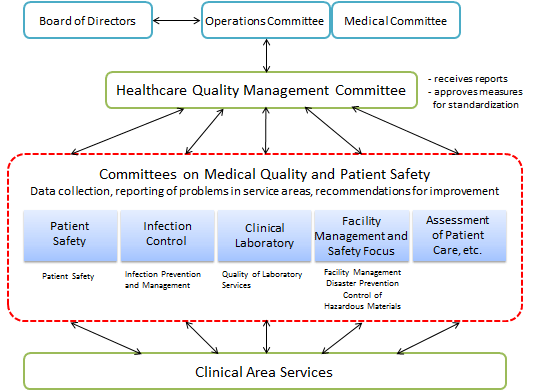●HOME > The Quality and Safety of Care in our Hospital
The Quality and Safety of Care in our Hospital
Medical safety is one of the most important aspects of hospital management. At KCH, we have an ongoing process of assessment and improvement for the quality and safety of care, in order to meet the demands of a major hospital that provides acute stage health care.
- Formulation of Guidelines for Medical Safety Management
Addressing the issue of medical accidents is paramount for medical safety. Focusing on human error in the workplace, our medical safety office creates, reviews and implements uniform measures, which are based on the importance of a safety-focused workplace culture and system of management of the hospital environment.
- A Medical Safety Office and Planning for the Safety and Quality of Care
Our medical safety management office operates at the center of our approach to safety, staffed with specialists from each medical department. Planning for the safety and quality of care is reviewed annually by quality managers who are appointed throughout the hospital’s organizational structure. - A Medical Safety Committee
Our general risk manager heads a medical safety committee comprised of safety managers from various areas of the hospital structure. The committee meets monthly to review the investigation and analysis of any accident site, and directs measures in response, including staff and patient education.
Furthermore, designated quality managers have been dispatched to the service areas of the hospital to improve quality and safety on the frontline of care. The quality managers meet monthly and liaise with the medical safety committee and safety managers on issues of quality and safety.

- Safety Training for Employees
 We have programs for safety training which includes triannual general safety workshops and a two-day safety workshop for each specialization, which includes items such as risk perception training. Biannual two-day workshops are also undertaken for the various medical teams within the hospital, which aims to improve safety in the multidisciplinary setting.
We have programs for safety training which includes triannual general safety workshops and a two-day safety workshop for each specialization, which includes items such as risk perception training. Biannual two-day workshops are also undertaken for the various medical teams within the hospital, which aims to improve safety in the multidisciplinary setting.
- eoccurrence Prevention Based on Safety Data.
The medical safety office receives mandatory reporting of all safety incidents in the hospital, which are assessed, analyzed and responded to, and the acquired data are used for recurrence prevention. - Other Measures
1) Standardized safety procedures, which are reviewed for improvement on an ongoing basis.
2) Medical Accident Prevention Week
3) A framework for the independent proposal of safety measures by self-formed staff teams.
4) Expansion of risk perception training.

